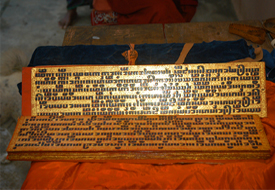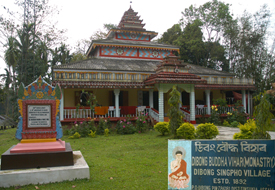Known as a bustling seat of ancient Tantrism and one of the few remaining places in India that still prides itself in preserving the practices of the occult, very few outside of Assam would know that many centuries ago, Assam was a hotbed of Buddhism too.
Changing trends in religious influences and social metamorphosis might or might not have changed who or how some ancient shrines that have survived till modern day Assam are worshipped today, but artefacts, archaeological findings and word of mouth appear to demonstrate the Buddhism has had its days of glory in ancient Assam.
Beliefs state the Padmasambhava, the founder of Tibetan (also known as Vajrayana) Buddhism, died in Hajo, a town 28 kilometers from Guwahati. Nagarjuna, another leader of Mahayana Buddhism, is said to have erected a Caitya(Memorial) in Hajo around the 1st or 2nd century AD. Some scholars believe that this Caitya was converted into a Hindu temple around the 3rd or 4th century AD. The temple of Hayagriva-Madhava in Hajo is considered a pilgrimage from Southeast Asia.
The 7th century AD Buddhist traveller Huen Tsang from China travelled across Assam during the reign og Bhaskarvarman, who although not a Buddhist himself, had a soft corner for the religion. Scholars vary on Hurn Tsang's observations on Buddhism in Assam, some saying that he did not find any trace of it, and some stating that he observed it being practised secretly due to its esoteric practices. However, Bhaskarvarman did travel with Huen Tsang to the court of King Harsha in Kanauj to attend a large Buddhist conference.
 |  |  |
Most traces of the great Mahayana Buddhism are now erased from modern Assam - what remains are just some relics, legends and historical analyses. Probably history will never reveal what happened during the phase when this tradition got lost in Assam and how Buddha came to known as an incarnation of the Hindu God Vishnu and Caitya plinths gave way to temples - but Mahayana thrives in Arunachal Pradesh (formerly a part of Assam) due to it's proximity with Tibet and the presence of medieval monasteries following pure Tibetan traditions like the Galden Namgey Lhatse, popularly known as Tawang Monastery.
In modern Assam, Buddhism survive in it's Theravada form, mainly due to the presence of communities like the Tai (Phake, AIton, Khamyang and Turunng), Singphos, Khamti, Chakmas and the Chittagong Baruas. Interestingly, all these communities are very small and have migrated to Assam from various Southeast Asian countries in and around the 18th century; they are often considered endangered and they preserve their cultures staunchly.
The Theravada traditions they follow are ancient and as a community, they can be considered as being the most peace loving in India. Theravada Buddhist Vihars are dotted across Assam, especially in the Tinsukia and Dibrugarh districts of Assam. These shiny, clean and peaceful Vihars showcase the traditions and cultures of some of the most exotic but endangered communities of Southeast Asia.